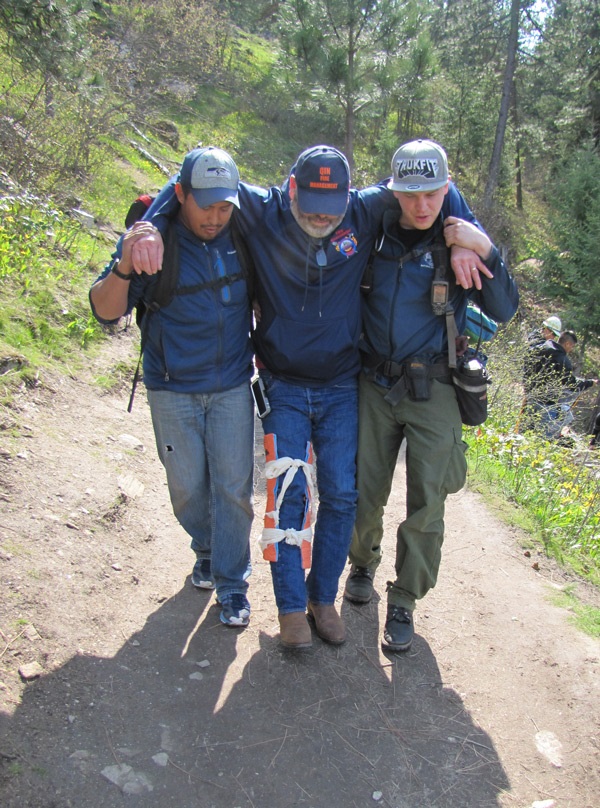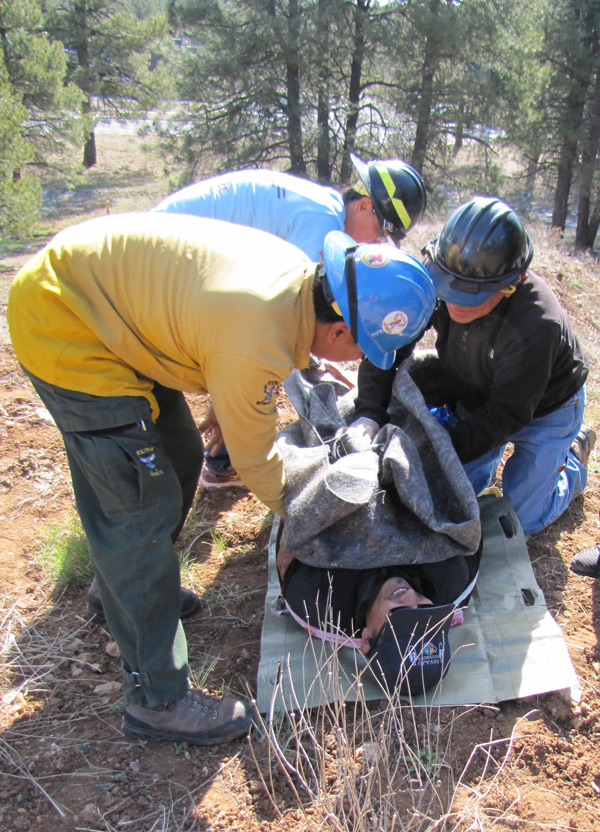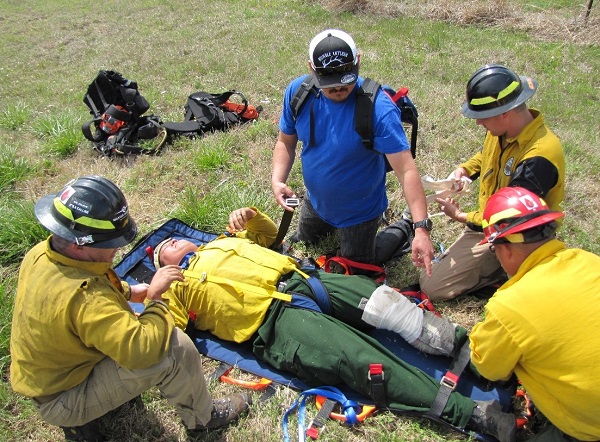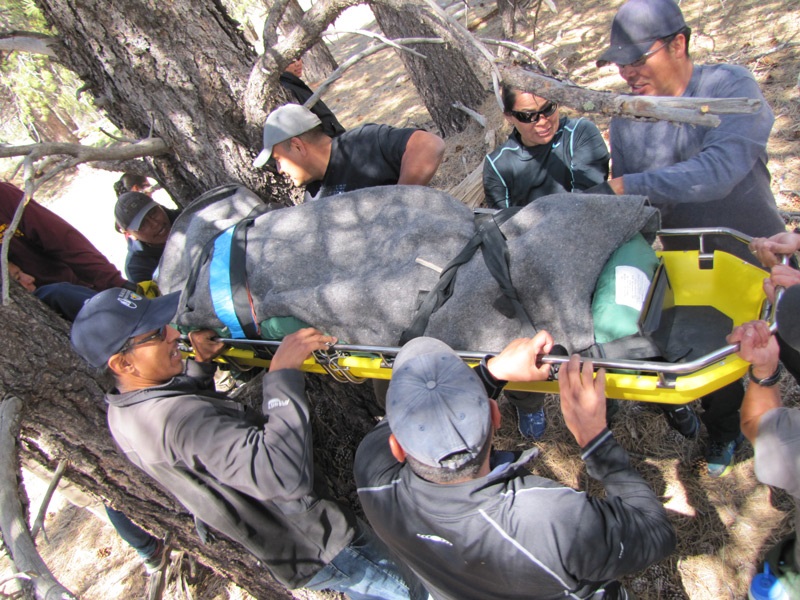You are viewing ARCHIVED content published online before January 20, 2025. Please note that this content is NOT UPDATED, and links may not work. Additionally, any previously issued diversity, equity, inclusion or gender-related guidance on this webpage should be considered rescinded.
Author: Robyn Broyles
LEGACY OF THE DUTCH CREEK INCIDENT
On July 25, 2008 a felling accident occurred on the Eagle Fire of the Iron Complex located on the Shasta Trinity National Forest. This accident, commonly known as the Dutch Creek Serious Accident, killed firefighter Andrew “Andy” Palmer and forever changed how the wildland fire community prepares for and responds to medical incidents.
In response to the Dutch Creek Incident, in 2010, the National Wildfire Coordinating Group (NWCG) began implementing institutional changes. These include standardizing medical emergency procedures and protocols for communication centers and requiring Incident Management Teams (IMT) review emergency medical procures every operational period.
A year after these changes took effect; BIA began providing wilderness first aid training to wildland firefighters. This effort, internally referred to as the “BIA First Aid Project,” was the start of BIA’s use of the wilderness medicine curriculum.
The first class using the wilderness medicine curriculum was the Wilderness First Responder (WFR) Training. It took place in 2011 with 13 students. The advanced course teaches the Six Wilderness Protocols, how to address complex logistical medical transports and how to interface with local EMS responders and IMT personnel.

Wilderness First Responder students transport a stable patient during a WFR training simulation. BIA Photo by Michelle Moore, Program Coordinator.
WILDERNESS FIRST AID PROGRAM
The Bureau’s initial training goal was to certify two WFRs for every hand crew, engine, helitack and wildland fire module in Indian Country. Since then, BIA has hosted 21 WFR classes and added an additional eight-hour first aid course to the wilderness medicine curriculum called Leadership Fundamentals for Medical Incidents (LFMI). This eight-hour wilderness first aid class offered to all Indian Country fire personnel.
In total, over 740 students from more than 50 Indian Country fire crews, including BIA, Office of Justice Services have certified. This represents about 60% of Indian Country’s permeant fire management workforce, more than double BIA’s initial goal!
Seven years after the First Aid Project launched, demand for the critical, life-saving training has expanded the Project to a fully funded, well-supported BIA Program.

Wilderness first responders learn how to package a patient in the wildland fire environment. BIA Photo by Michelle Moore, Program Coordinator.
WILDERNESS MEDICINE CURRICULM
All Wilderness First Aid training classes open by discussing the lessons learned from Dutch Creek After Action Review. These lessons demonstrate how risk management decisions and patient transports can change the life of a patient.
Students receive hands-on training to learn first aid skills such as how to preform basic critical systems interventions like CPR, how to use an AED, how to perform rescue breathing and applying tourniquets. Exercises also teach students how to identify and communicate patient severity using the Medical Incident Report and the associated color-coded triage system. Additionally, firefighters practice four standard radio transmissions familiar to all EMS responders and IMT personnel.
By walking through scenarios and rehearsing the right communication protocols, firefighters gain confidence in taking command of a medical incident and making risk management decisions. These include how best to transport a patient to definitive care.
When students complete the courses, training officers document firefighter’s participation in the in the Incident Qualifications and Certifications System (IQCS). This shows those who review a firefighter’s master training record that they have taken wilderness first aid training.
These trained professionals contribute to positive outcomes on wildland fire incidents every year, affecting countless personnel touched by the medical incidents.
BIA’s use of the curriculum and investment in resources represents a national commitment to provide Indian Country firefighters with first aid skills designed for the environment they work in. To date, this is the only curriculum teaching firefighters these critical, life-saving skills, and BIA is the only Bureau offering it to wildland firefighters.

Firefighters practice giving first aid to a firefighter during a simulation in El Reno, OK. Credit: Michelle Moore, Program Coordinator.
WILDERNESS FIRST RESPONDERS
The Wilderness Medical Society sponsors WFR courses, which are specific to non-medical practitioners. This allows BIA to meet industry standards as outlined by the Wilderness Medical Society while fulfilling Occupational Safety and Health Administration (OSHA) requirements.
While LFMI and WFR courses teach how to provide first aid skills and how to communicate and manage medical incidents, WFR training teaches in depth techniques to stabilize, package and safely transport patients. This includes how to stop CPR after thirty minutes, reduce simple dislocations, clean a wound, clear a spine, and treat severe asthma and anaphylaxis. Wilderness medicine practitioners refer to these techniques as the Six Wilderness Protocols, and are a defining difference between the eight-hour LFMI course and the five-day WFR training.
This difference is the key reason BIA pays certified wilderness response professionals to teach the WFR training.
In addition to providing training, BIA also purchases first aid equipment and trauma kits for field units, a value of $8,800 per class. By investing in the students with this equipment, WFRs leave knowing they have the right tools, knowledge and confidence to provide appropriate first aid and leadership during a medical incident.
LEADERSHIP FUNDAMENTALS FOR MEDICAL INCIDENTS
All Indian Country firefighters should have the knowledge, skills and confidence to perform basic first aid while working in the field. That is why BIA began expanding the wilderness medicine curriculum in 2017 to include a Leadership Fundamentals for Medical Incidents class.
Taught by certified WFRs, the eight-hour LFMI course is the first ever wildland fire-specific OSHA-compliant eight-hour first aid class taught by any land management agency. In one day, it squeezes the essentials of how to provide first aid, communicate a medical incident, and make a determination on how to transport a patient to care.
In its first year, BIA certified 112 employees during four classes. In 2018, the number of sessions doubled, providing 166 additional employees this essential training.
SUSTAINABLE LEADERSHIP
To develop sustainable instructors for the LFMI class and to save contracting costs, $4.500 per class, BIA began taking steps to train certified WFRs to become LFMI Instructors.
These effort required safety specialists to identify requirements for instructors, develop LFMI curriculum and teach WFRs how to teach the course.
To qualify as a LFMI Instructor, firefighters must maintain their WFR certifications, complete two first aid train-the-trainer courses and complete Facilitative Instructor Training (M-410).
In 2018, BIA began hosting Train-the-Trainer classes. The initial goal was to produce 15 certified LFMI Instructors, but due to the overwhelming interest from WFRs, BIA exceed their goal, certifying 30 new LFMI instructors in 2018.
BIA plans to host four additional LFMI classes in 2019, after which the class will be self-sustaining.
REGIONAL COORDINATORS
To assist the Branch safety staff with coordinating and delivering wilderness first aid classes, seven Regional Coordinators are volunteering to manage the continuing education needs of employees. Coordinators help monitor training records to ensure WFRs maintain certifications, organize training, and provide expertise for LFMI Instructors. This volunteer effort demonstrates to program managers the personal value and importance the Wilderness First Aid Program has for Indian Country fire crews.
STRATEGIC GOALS
BIA's strategic goals are to continue investing in the Wilderness First Aid program courses to provide enough training classes annually to account for growth and turnover within crews and ensure WFRs and LFMI Instructors maintain currency.
While extremely tragic, the lessons Andy Palmer left with the wildland fire community continue to ripple out. With each wilderness first aid class BIA teaches, Andy’s lessons forever change their lives and potentially the lives they may affect during a medical incident.
For Immediate Release: June 1, 2018


